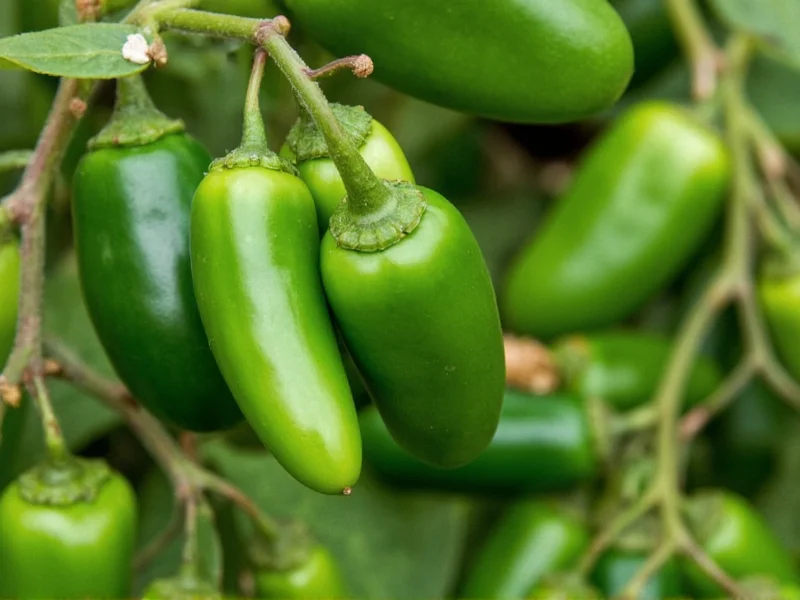Understanding exactly how many scovilles is a jalapeno requires recognizing that heat levels can vary significantly based on growing conditions, variety, and even individual pepper characteristics. This comprehensive guide explains everything you need to know about jalapeño heat levels, their position on the Scoville scale, and what this means for your cooking and palate.
Understanding the Scoville Scale and Jalapeño Heat Measurement
The Scoville scale measures the pungency or heat level of chili peppers and other spicy foods. Developed by pharmacist Wilbur Scoville in 1912, the scale quantifies capsaicin concentration—the compound responsible for that burning sensation. While modern high-performance liquid chromatography (HPLC) provides more precise measurements today, the Scoville Heat Unit (SHU) remains the standard reference.
When considering how many scovilles is a jalapeno, it's important to understand that no single number tells the complete story. Jalapeños exhibit natural variation in heat intensity due to several factors:
- Growing conditions: Soil quality, climate, and water stress affect capsaicin production
- Ripeness: Red jalapeños (fully ripe) often measure hotter than green ones
- Seed placement: The white pith and seeds contain the highest capsaicin concentration
- Cultivar differences: Some jalapeño varieties are selectively bred for milder or hotter profiles
Jalapeño Heat Range Explained
The standard jalapeno scoville rating falls between 2,500–8,000 SHU, but this range represents significant variation. To put this in perspective:
| Pepper Type | Scoville Heat Units (SHU) | Heat Comparison |
|---|---|---|
| Bell Pepper | 0 SHU | No heat |
| Jalapeño | 2,500–8,000 SHU | Mild to medium heat |
| Serrano | 10,000–23,000 SHU | 2-3x hotter than jalapeño |
| Habanero | 100,000–350,000 SHU | 15-40x hotter than jalapeño |
| Ghost Pepper | 855,000–1,041,427 SHU | 100-400x hotter than jalapeño |
This scoville scale comparison chart shows where jalapeños sit relative to other common peppers. While jalapeños rank as mild-to-medium peppers, they deliver noticeable heat that most palates can handle with proper preparation.
Factors That Influence Jalapeño Heat Levels
Several elements determine the actual heat you'll experience when eating a jalapeño:
Environmental Conditions
Peppers grown in stressful conditions (less water, higher temperatures) typically produce more capsaicin as a defense mechanism. This explains why the same jalapeño variety might measure differently across growing seasons or regions. Understanding why are some jalapenos hotter than others often comes down to these environmental factors.
Ripeness and Color
Green jalapeños (harvested early) generally measure toward the lower end of the scale (2,500–5,000 SHU), while red jalapeños (fully ripe) often reach 5,000–8,000 SHU. The ripening process concentrates capsaicin, making red jalapeños noticeably hotter on average.
Preparation Methods
How you prepare jalapeños significantly impacts perceived heat. Removing the white pith and seeds—where capsaicin concentrates most—can reduce heat by up to 80%. This practical knowledge helps when answering how to reduce jalapeno heat in recipes.
Practical Implications for Cooking and Consumption
Knowing the jalapeno pepper heat level helps you make informed decisions in the kitchen:
- Substitutions: If a recipe calls for jalapeños but you want milder heat, consider poblano peppers (1,000–2,000 SHU). For more heat, try serranos.
- Handling safety: Always wear gloves when handling hot peppers and avoid touching your face. Capsaicin doesn't wash off with water alone—use oil or dairy products for relief.
- Cooking effects: Heat doesn't destroy capsaicin; cooking actually helps distribute it more evenly throughout your dish.
- Preservation impact: Pickling jalapeños slightly reduces perceived heat while maintaining their Scoville rating.
Measuring Heat: From Subjective Testing to Modern Science
Originally, the Scoville test involved diluting pepper extract in sugar water until the heat became undetectable by human tasters. This subjective method has largely been replaced by HPLC, which precisely measures capsaicinoid concentration and converts it to Scoville units. This scientific advancement explains why modern scoville heat unit measurements provide more consistent data than historical references.
Common Misconceptions About Jalapeño Heat
Several myths persist about measuring and experiencing jalapeño heat:
- Myth: All jalapeños have the same heat level
Fact: Significant variation exists even within the same plant - Myth: Smaller jalapeños are always hotter
Fact: Size correlates weakly with heat; growing conditions matter more - Myth: The seeds make peppers hot
Fact: Seeds themselves contain minimal capsaicin; the placenta (white pith) holds most heat











 浙公网安备
33010002000092号
浙公网安备
33010002000092号 浙B2-20120091-4
浙B2-20120091-4